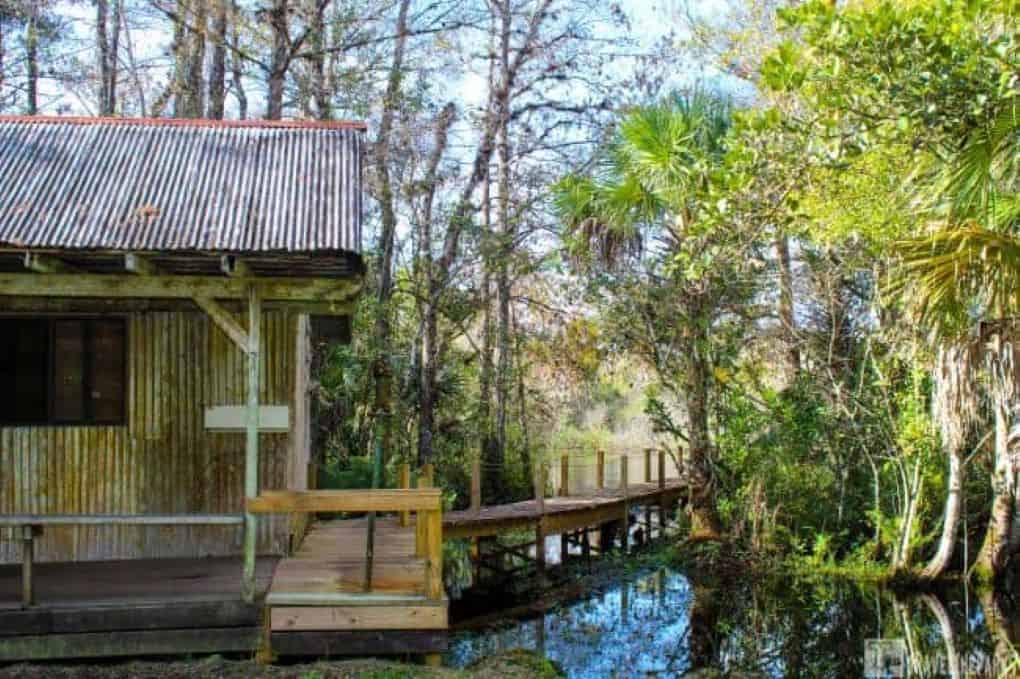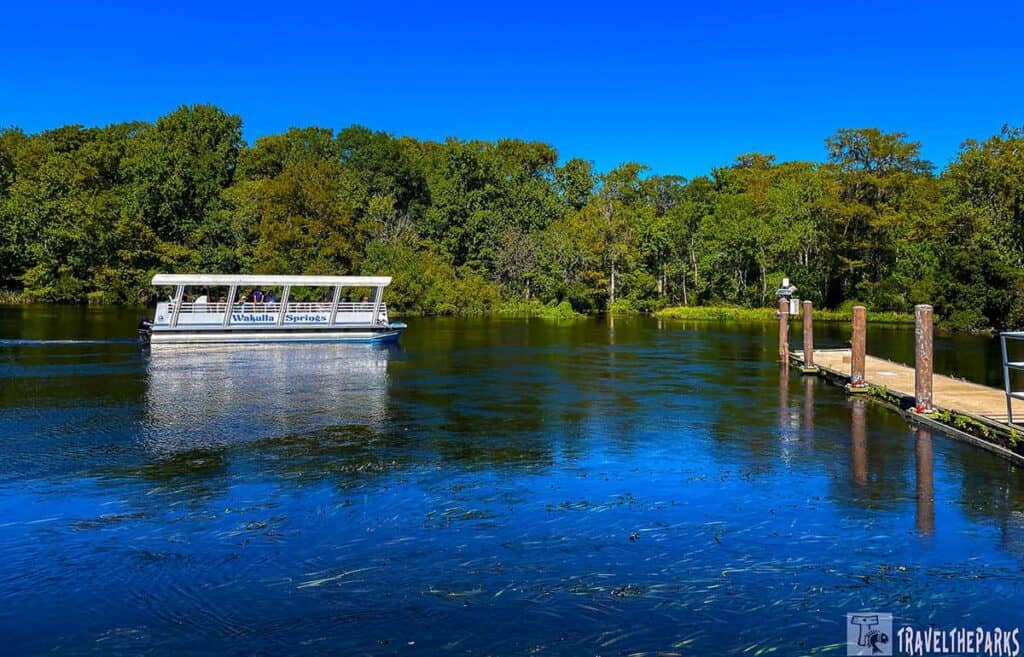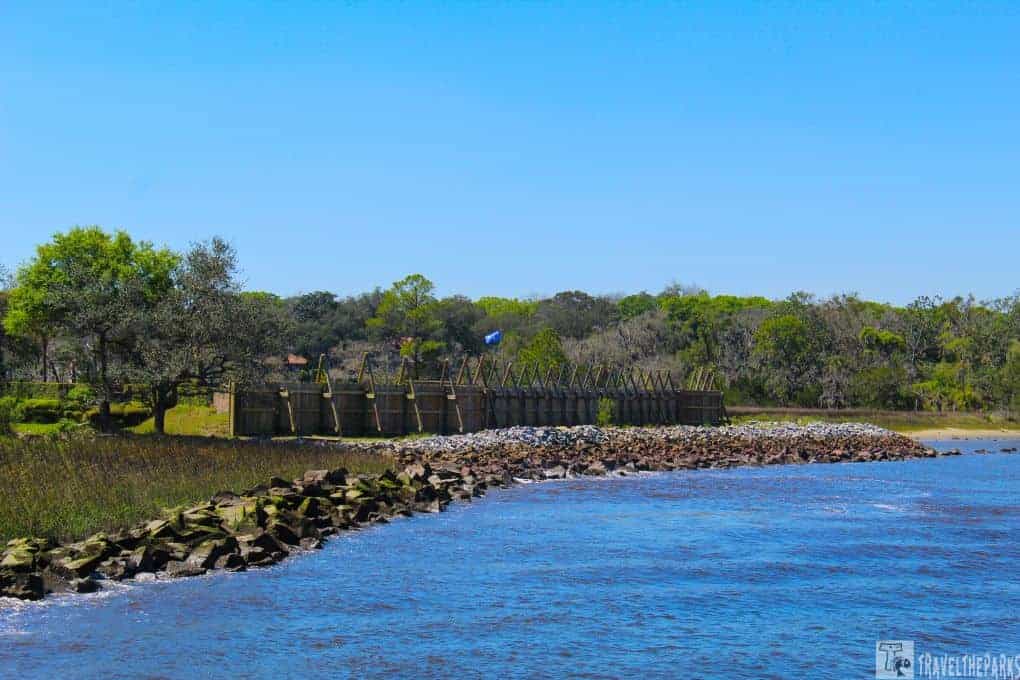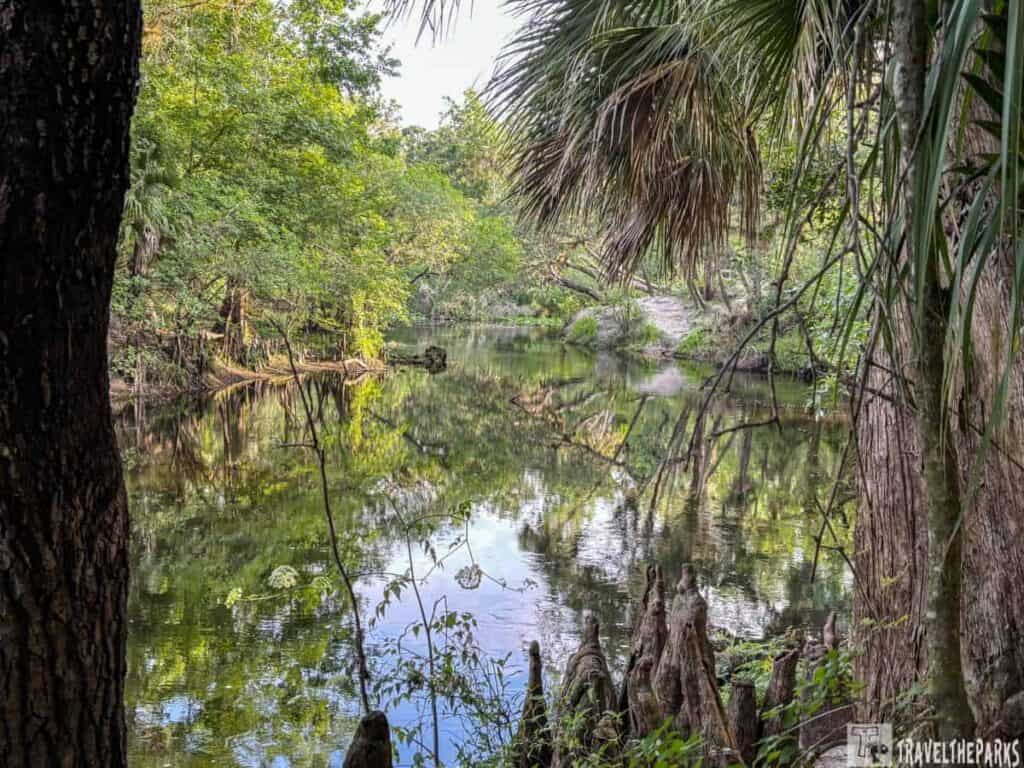Oh, the places you can go! We had been told of an isolated cabin called the “Fakahatchee Hilton.” They said it is easily reachable from the Janes Memorial scenic drive and East Main tram. Wildlife such as the elusive Florida panther and Everglades mink, are frequently spotted there. Alligators are also common sightings along this road. Over the Christmas break, we said let’s go adventuring! and take the road less traveled.
Compared to Big Cypress and the Everglades, Fakahatchee is often overlooked. With only a few visitors, Fakahachee seems a world away from the rest of the world. Most people seldom see this hidden paradise.

Table of Contents
Fakahatchee State Park is Florida’s Largest State Park
I ask myself how have I not known that Fakahatchee Strand is Florida’s largest state park. At over 85,000 acres, it comprises flat prairies, sabal palmettos, small hardwood forests and wetlands, which are the hallmarks of southern Florida’s inland habitats. Thanks to the Susan Orlean’s best-seller The Orchid Thief, the park is renowned for its rare and endangered orchids. Most notably the elusive ghost orchid (Dendrophylax lindenii).
This post may contain affiliate links, meaning if you purchase something through one of these links, we may earn a small commission at no extra cost to you! Read the full disclosure policy here.

Where is Fakahatchee Strand State Park & Preserve?
To reach the main park entrance, take I-75 to exit 80 onto State Road 29. Proceed south for 15-miles. Much of the road trip along SR 29 to Copeland is untouched wild Florida. Note the panther fencing on either side of the road. The park entrance is on your right in Copeland. Make the 180-degree turn onto Janes Scenic Drive. The ranger station is at 137 Coastline Drive.
To reach the Big Cypress Bend boardwalk from the park entrance, we travel south for 3-miles to U.S. 41. Turned right and went 7- miles to the boardwalk. There is no parking lot, only a gravel pullout.

Leaving Central Florida at 6 AM, the early start got us through Lake Placid with little traffic. Using FL-29, we headed south through panther country until we reached the state park, just north of US-41.
Fakahatchee Ranger Station – Janes Scenic Drive
The park, open 365 days a year from 8 am till sunset. Immediately upon entering the park, signage directed us to the ranger station, restrooms, and fee station. There is an honor system for paying the $3 park fee. All proceeds go to directly to the park. Equally important maps with trail information are available at the ranger station or use this downloadable map.
An old fire observation tower stands at the park’s entrance. Prescribed burns are essential to rejuvenating fire-dependent habitats like those in the park.
Following a quick look around the ranger station, we headed towards the farthest trail, the East Main Tram, about 6-miles down the Janes Scenic drive. The entire road is approximately 11 miles long and showcases the beauty of the preserve, including wet prairies, cypress swamps, and tropical hammocks. The last 5-miles of the scenic road is only accessible to hikers and bikers (no cars).

Why is it called the Janes Memorial Scenic Drive?
They named the drive after three brothers who founded a tomato farm in Copeland in the 1930s. The brothers additionally owned and operated a general store and post office on the east side of State Route 29, near the entrance to the park. They were demolished many years ago.
Tackling the Janes Scenic Drive to the Fakahatchee Hilton
The 15 mph speed limit is essential if you want to see wildlife. At the present time, the road is actually in pristine condition. Our compact car navigated the road with no issues whatsoever. From time to time, the road may have ruts and potholes caused by seasonal flooding.

This is wild Florida at its finest and it’s amazing. Winding through a wet prairie, there’s water along both sides and, if you are lucky, can spot alligators sunning alongside the road. I saw so many gators that I lost count. The remains of an old limestone quarry lie next to the ranger station on Janes Scenic drive. The lake often attracts herons, ibis and other migratory waterfowl.
Janes Memorial Scenic Drive turns into a one lane gravel road at the tree lined portion. Here is where things get tricky. You’ll have to share the road with cars going in the opposite direction. In due time, we reached the parking area and locked gate leading to the East Main tram.
Note: Park staff and volunteers maintain Jane’s Scenic Drive year-round, but weather events can sometimes affect its condition.

Hiking Trails in Fakahatchee from Janes Scenic Drive
In the strand, logging for bald cypress trees occurred in the 1940s and 1950s. The timber company constructed 192 miles of roads referred to as trams. Build using a Karst limestone base, they remain high and dry, even in the wet season. The Janes scenic drive overlays the original railroad tram. The trails branch off the main road, further into the swamp. In general, the park is divided into four major use zones: Big Cypress Bend Boardwalk, East River, Jones Grade lakes, and Janes Memorial Scenic Drive.
It is advisable to bring along plenty of water. The trails can be muddy, so wear proper walking or hiking shoes. We had a trekking stick for the slippery sections too.

Guided Swamp Walks or Ghost Rider Tram Ride
If you are interested in an immersive experience to learn and see more of this remarkable area, plan to take a guided swamp walk arranged through the Friends of Fakahatchee (orchidswamp.org), guided by a master naturalist. The tour traverses through the drier prairie areas and sloshed our way through the swamp. We spent 2-hours, sloshing around learning about the unique natural characteristics of the park. Specifically, the Karst limestone geology and the biologically rich flora and fauna. A very rewarding experience.
Note: they recommend wearing long pants, wade boots or wet shoes, and a change of dry clothes.
The Ghost Rider tram, named after the Ghost Orchid found here, can be used if you prefer not to get wet. A naturalist will point out various wildlife and plants as they do the driving for you.

Finding Solitude on the East Main Tram Trail
Prior to hitting the trail, we liberally applied bug spray. The temps are in the mid-70s today. Therefore, we expected the mosquitoes would be an issue. Quickly we grabbed the day pack and camera. Jogging around the gate to begin our 2-mile hike to the Fakahatchee Hilton cabin. Straightaway the canopy closed in. The mosquitoes buzzed. Overall, they didn’t bother us.
All in all, the tram trail ran in a straight line. Mostly, it was dry with a few muddy spots that we just scooted around. I think the first thing we noticed was the quiet. No road noise, just the sound of birds. The entire time, we did not see another soul. It was genuine solitude.

Fakahatchee Hilton is a World Away!
It immediately came to mind how they called this place “the Amazon of North America.”. I was awestruck at the abundance of plants. There were beautiful orchids, bromeliads, and air ferns hanging from huge old cypress trees. The tangles of strangler figs and Virginia creepers made it appear as if we were in a rainforest. We discussed how cutting through the humid Florida forest must have felt like torture for the first explorers. The trail appeared to go on and on, further than 2-miles. I kept thinking, did we miss it?
Occasionally, we would briefly stop peering through the binoculars to see if wildlife was visible in the distance. At the moment, what we thought was an animal would be just a rotting palm frond. Scattered Royal Palms grow tall on the edges of the tram. Moving silently, we continued forward. Suddenly finding an owl on an old stump and later watching red-shouldered hawks hunting. The poignant cry is haunting. It was incredibly beautiful!
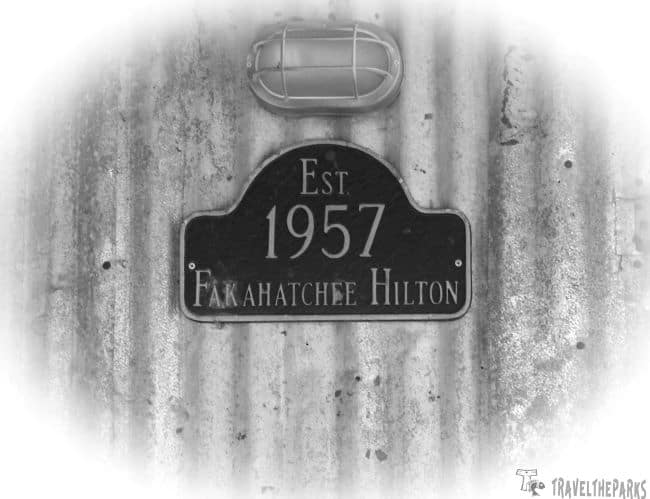
Solitude & Isolation at the Fakahatchee Hilton
Eventually, we reached a clearing in the subtropical wilderness. This was the Fakahatchee Hilton, the cabin we had been striving to get to. It feels like Old Florida. This quaint cracker-style cabin is a throwback to an earlier time. Mounted on the front of the privately owned cabin is a sign proclaiming Fakahatchee Hilton, established 1957. The owners of this vintage abode welcome visitors. Be respectful of their property. The inviting front porch swing is a great way to take in the setting and the picnic table is the perfect place to take a snack break.
Note: Remember, the fishing cabin is private property, so please be considerate.

Behind the Fakahatchee Hilton cabin, a wooden walkway leads to a small lake. We took a few moments to appreciate this idyllic spot. Today, only two massive gators prowl the waters. I am always mesmerized by gators. These prehistoric reptiles have survived since the ice age. We spent an hour watching them slowly maneuver through the water. At this time of the year, gators often bask in the sunshine to maintain their body temperatures. Whenever we fish on local lakes, I am always fascinated by how they just kind of hang on the surface of the water. The larger of the two reptiles may have been an American crocodile. The distance made it hard to tell.

Back in the clearing, a forlorn old fashioned outhouse stands on the left trail. The path dead ends at a small wooden plank bridge. Overgrown with tall ferns and other plants, the other side is nearly impossible to navigate.

Appreciating the Setting – Fakahatchee Hilton
Venturing back to the sunlit area in the front, we sat at the one lonely picnic table. It was time for a light lunch. It’s very peaceful here alongside the slough. While enjoying our snack, we notice an endangered Red-Cockaded Woodpecker pecking a dead cypress, looking for insects. We discussed whether to continue further up the right-hand trail to the Jones Grade trail (7-miles). Instead, we turned around and headed back to gate 12 and Janes Scenic Drive. We’ve got a few more trails to explore before the park closes at dusk.
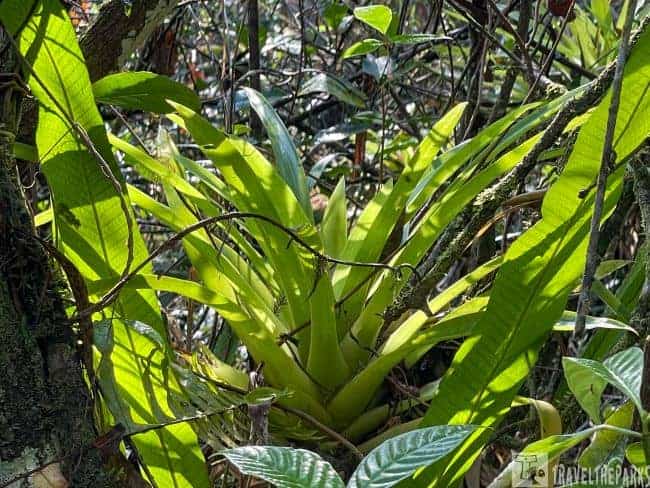
Gate 16 Mud Tram Trail
From the parking lot it is 4.0-miles to the Gate 18 on the main tram-Janes Scenic drive. This marks the beginning of the Picayune Strand State Forest. The Picayune was most notable for the infamous “swampland in Florida” scam. However, that is another story.

During our first 1.5-mile walk on the Janes Scenic drive, we reached Gate16, the mud tram trail. The mud tram will take you 7.7-miles to the park boundary, however, it is 4.4-miles to Four Stakes prairie trail. If you choose to walk all the way round, you could take the West Main tram. For today, it is a short 2-mile trail (in & out). The lowlands here have cypress strands, wet prairie, and pine flatwoods, while the highlands have hardwood hammocks.

We were surrounded by brilliant cabbage palms, pond apple trees, and pond apple willows along the majority of the trail. The forest in this stunning location seems to close in on you. I spot a stunning Guzmania bromeliad grow atop a decaying log. Like all Epiphytic plants, they thrive in the humid Florida heat. I spied an eastern diamondback rattlesnake coiled in the underbrush, silent but deadly. He was just off the tram. We gave him a wide berth. The further into the forest we trek, the more enclosed it feels. The mosquitoes became quite annoying, forcing us to turn back. And the answer is yes, it was muddy due to rain the previous day.

West Main Tram Trail
We will hike 4-miles from Gate 7 to the intersection of the Four Stakes Tram. The gate is only 2.0-miles from the ranger station on the Janes Scenic drive. The parking area is small, but we are the only ones hiking this afternoon.
The goal for today is to hike to the end and then retrace our steps directly back the way we came. There are very few obstacles on this hike because it is relatively level. The trail first passes through a forest of primeval trees. Eventually, the double track leads to a marshy grassland prairie. As the sun shines through this magnificent forest, the immeasurable beauty of the plants comes to light. Walking slowly and being quiet will increase your chances of seeing wildlife. As we approach the grasslands, a deer appears and dashes away before I can take its photo. Even though we did not see any bears today, this is an ideal black bear habitat.

Jones Grade lakes
The turn off is only a short distance from I-75 (Alligator Alley). An indistinct gravel sideroad leads to the hiking trail and the lakes. They created the lakes during the construction of Alligator Alley. The Karst limestone was used to stabilize the highway. We did not have enough time on this trip to see the lakes. It is said that the fishing here is amazing!

Big Cypress Bend Boardwalk
There are several ways to explore this wild place, often called the “Amazon of North America.” The most accessible is the 0.6 mile boardwalk along Hwy 41 (Tamiami Trail) that meanders through a stand of virgin cypress ending at a large viewing deck overlooking a gator hole. On this day, there was no one there, so we made the stop.

In addition to a plaque showing that this is a registered National Landmark, there is a hard-packed gravel trail leading to the boardwalk. Several signs identify the animals and plants on the boardwalk. All things considered, there is an abundance of wildlife viewing opportunities along the 2,000 foot boardwalk. A newly constructed observation platform overlooks one of the small lakes. I could see several blue herons and white egrets fishing the edges of the pond. Our attention was drawn to a pair of bald eagles performing a mating ritual above us. Bald eagles mate in early December. There is a nest closer to the boardwalk.

Consider a visit to Collier Seminole State Park has trails and interpretive exhibits just a few miles further down the road.
East River Paddling Trail
Located one mile east of the Big Cypress Bend boardwalk and five miles west of Highway 29, the East River launch is open to non-motorized vessels from 8 a.m. to sunset. The paddle trail is 5.5 miles long one way. Fakahatchee bay connects to the Ten Thousand Islands by tidal brackish waters. The water is easy to navigate as it travels through small lakes via mangrove tunnels. There are alligators, turtles, and birds of all kinds to be found here. Several of the waters here allow you to fish for snook and tarpon with a saltwater license.
Note: Currently, the newly refurbished East River Paddle Trail is open by appointment only. Guests may still access the trail by reservation. For information on daily reservations for the East River Paddling Trail, please call the park office at 239-695-4593. The trail is has no markers.

Final Thoughts: Fakahatchee Hilton by Janes Scenic Drive
Known as the “Amazon of North America,” this remote location provides a true wilderness experience, surrounded by the pristine beauty of the Fakahatchee Strand Preserve. It is a perfect destination for those seeking solitude and a connection with nature. Whether you’re a nature lover, photographer, or seeking an off-the-beaten-path adventure, this destination promises an unforgettable and immersive experience in Florida’s natural wonders.
For an in-depth exploration of Florida’s largest state park, take a trip down Janes Scenic Memorial Drive, including the Fakahatchee Hilton and take it all in. This may be the best kept secret in Florida. On our next visit, thinking of doing the Moonlit Fakahatchee Tram Tour. We are already planning our returning to this magical place!
Would you like to tell us about your experience with the Fakahatchee? If you plan to visit, what are your plans? We love when you share your adventures with us!

